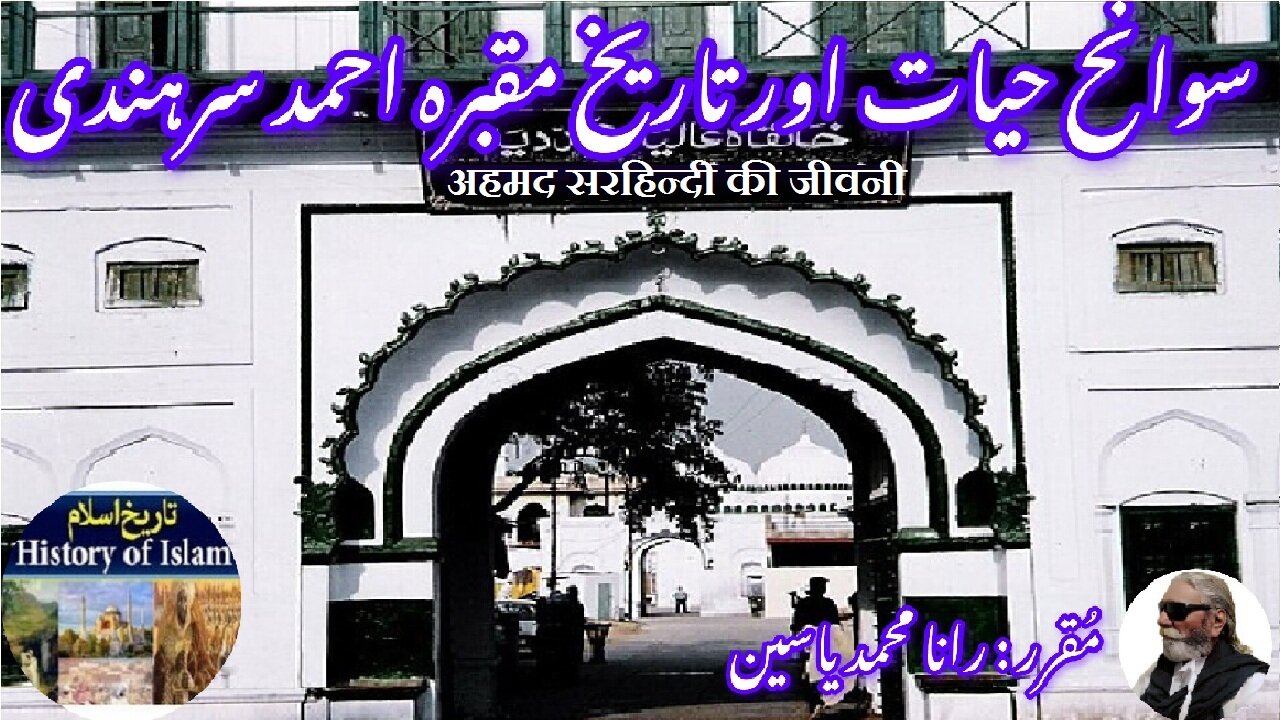Premium Only Content

Biography of Ahmad Sirhindi | अहमद सरहिन्दी की जीवनी | احمد سرہندی کی سوانح عمری اور مزار کی تاریخ
@islamichistory813 #biography #ahmad #sirhindi #sufisaint #cultural #heritage #biography #islamic #mysticism #islamic #philosophy #shrine #historical #figures
Biography of Ahmad Sirhindi and the history of his shrine
Dekhti Aankhooon aur sountay kaanoon ko Asslamoalaikum, sisters, brothers friends and elders, in informative series videos of Islamic ascolars, sufisaints, cultural heritages, islamic philosophys, islamic mysticisms and historical figures. today we are describing biography of Ahmad Sirhindi and the history of his shrine.
Ahmad Sirhindi, a renowned Islamic scholar and Sufi mystic, was born on 26 May 1564 in the village of Sirhind, Punjab, into a distinguished Punjabi Muslim family. His early life and education were shaped by the intellectual and spiritual environment of the Mughal Empire, which was a period of cultural fusion but also a time of significant religious and political change. Sirhindi received much of his early education from his father, Abdul Ahad, who was a respected religious scholar. Additionally, he learned from his brother, Muhammad Sadiq, and from Muhammad Tahir Al-Hoori, a prominent scholar based in Lahore. These early years were marked by a solid foundation in Islamic studies, particularly in theology and Sufism, which deeply influenced his spiritual outlook and later contributions to the Islamic world.
Ahmad Sirhindi’s intellectual and spiritual journey was guided by his deep commitment to orthodox Islamic teachings, particularly those of the Sunni tradition. He was trained in various fields of knowledge, including Islamic jurisprudence, theology, and philosophy. His education was shaped by his exposure to traditional Islamic thought and Sufi mysticism, which had a significant influence on his understanding of Islam. As he matured, Sirhindi became increasingly drawn to the idea of reforming Islamic thought, advocating for a revival of what he believed to be the true essence of Islam. His quest for spiritual purity and doctrinal correctness led him to focus on the practice and preservation of orthodox Islamic law and values, positioning him as a critic of any deviations from the traditional practices of Islam.
Sirhindi’s rise to prominence came during the reign of Emperor Akbar (r. 1556–1605), whose policies of religious tolerance and the promotion of syncretic religious practices, including his creation of the Din Ilahi, were a point of contention among many orthodox Muslim scholars. The Din Ilahi, a new religious movement created by Akbar, sought to combine elements of various religious traditions, including Hinduism and Islam, and was seen by many traditionalists as a threat to the purity of Islamic doctrine. Ahmad Sirhindi was a vocal opponent of this movement, and he is best known for his staunch defense of Islamic orthodoxy against such heterodox ideas. He believed that the religious and spiritual integrity of Islam could only be preserved by adhering to its traditional teachings and rejecting syncretic practices.
One of Sirhindi’s most significant contributions to Islamic thought was his emphasis on the revival of orthodox Islamic practices and his reformist approach to Sufism. He became widely known as a *Mujaddid* or "reviver" of Islam, a title that reflects his mission to reinstate what he viewed as the pure and unaltered practices of Islam. His reformist ideology was based on the belief that the essence of Islam had been distorted by deviations from its foundational principles. He argued that it was essential to return to the core teachings of the Qur'an and the Hadith, and to reinforce the practice of Sharia (Islamic law) as the guiding principle for both spiritual and worldly life. This approach, which became known as the *Mujaddidiyya* movement, had a profound impact on the religious landscape of the Mughal Empire and beyond, influencing generations of Muslims in South Asia and other parts of the Islamic world.
Ahmad Sirhindi's writings were a critical aspect of his reformist agenda. His letters, known as *Maktubat-i-Imam Rabbani* (The Letters of the Imam), contain a wealth of theological, philosophical, and spiritual insights. These letters were written to his disciples, scholars, and rulers, providing guidance on matters of faith, practice, and governance. His writings addressed a wide range of issues, from spiritual development to the political and social implications of Islamic law. They also criticized certain Sufi practices that he believed deviated from the true path of Islam. Sirhindi's philosophical and theological contributions were foundational in shaping the religious thought of later generations, particularly in the Indian subcontinent.
In addition to his theological and philosophical work, Sirhindi was also a key figure in the development of the Naqshbandi Sufi order in India. He was initiated into the Naqshbandi order and became one of its most prominent representatives. However, Sirhindi’s approach to Sufism was distinct from that of many of his predecessors. While he maintained the core spiritual practices of Sufism, such as the remembrance of God (dhikr) and the cultivation of a close relationship with the Divine, he emphasized a more rigorous adherence to Islamic law and the rejection of practices he considered un-Islamic. His teachings advocated for a balanced approach, combining Sufi spirituality with the observance of Sharia law, and this earned him the title of *Mujaddid-i-Alf-i-Sani* (Reviver of the Second Millennium).
Ahmad Sirhindi passed away in 1624 or 1625, leaving behind a rich legacy that continued to influence Islamic thought in South Asia and beyond. His contributions to Islamic orthodoxy and Sufi spirituality are celebrated by his followers, who consider him a key figure in the revival of traditional Islamic practices. His tomb, located in Sirhind, Punjab, has become a major site of pilgrimage for his devotees, who come to pay their respects and seek spiritual blessings. The shrine of Ahmad Sirhindi is a symbol of his enduring influence and is considered a sacred place where people from all walks of life come to connect with his teachings. The shrine, with its tranquil surroundings, reflects the deep spiritual legacy of a man who dedicated his life to the reform and revival of Islam, advocating for a return to its authentic principles and practices.
Over the centuries, Ahmad Sirhindi’s influence has continued to grow, and his legacy as a *Mujaddid* remains a powerful force in the Islamic world. His emphasis on the preservation of Islamic orthodoxy, coupled with his commitment to the reform of Sufism and Islamic practice, has made him one of the most important figures in the history of South Asian Islam. His contributions to Islamic thought and his enduring legacy ensure that his teachings continue to resonate with Muslims today, especially those seeking a deeper understanding of the balance between spirituality and religious law. The shrine of Ahmad Sirhindi remains not only a place of pilgrimage but also a symbol of the vitality and enduring relevance of his vision for the Islamic world.
With this, we seek your permission until tomorrow, tomorrow we will describe the biography of Rabi'ah al-Basri and the history of his Shrine.
=============================
-
 5:33
5:33
ISLAMIC HISTORY
8 hours agoScholar Aisha Abdul Rahman Bewli Ayishah abdalrahman biyoli اسلامی سکالرہ عائشہ عبدالرحمن بیولی
2 -
 LIVE
LIVE
Glenn Greenwald
3 hours agoGlenn Takes Your Questions on Censorship, Epstein, and More; DNC Rejects Embargo of Weapons to Israel with Journalist Dave Weigel | SYSTEM UPDATE #505
19,124 watching -
 LIVE
LIVE
Barry Cunningham
1 hour agoLISA COOK | ADAM SCHIFF | LETITIA JAMES | ARE THEY BEING SACRIFICED BY THE DEEP STATE?
2,346 watching -
 LIVE
LIVE
MattMorseTV
1 hour ago $1.22 earned🔴Trump just SHATTERED the PROJECTIONS.🔴
823 watching -

Dr Disrespect
8 hours ago🔴LIVE - DR DISRESPECT - GEARS RELOADED GLOBAL LAUNCH - CRUSHING LOCUST
87.4K10 -
 LIVE
LIVE
SpartakusLIVE
5 hours ago$20,000 Hide and Seek Tourney w/ Stonemountain64 || #1 Rat wins the BIG CHEESE
354 watching -
 1:06:27
1:06:27
BonginoReport
3 hours agoBig Bad JB Threatens Trump! - Nightly Scroll w/ Hayley Caronia (Ep.120) - 08/26/2025
81.3K26 -
 1:02:26
1:02:26
Kim Iversen
3 hours agoIran Rejects Nuclear ‘Spy’ Inspectors — War Next?
28.6K62 -
 LIVE
LIVE
StoneMountain64
7 hours agoWARZONE LEGEND RETURNS. GHILLIE SUIT $20k TOURNEY.
138 watching -
 1:06:33
1:06:33
TheCrucible
3 hours agoThe Extravaganza! EP: 27 with Guest Host: Rob Noerr (8/26/25)
21.1K2